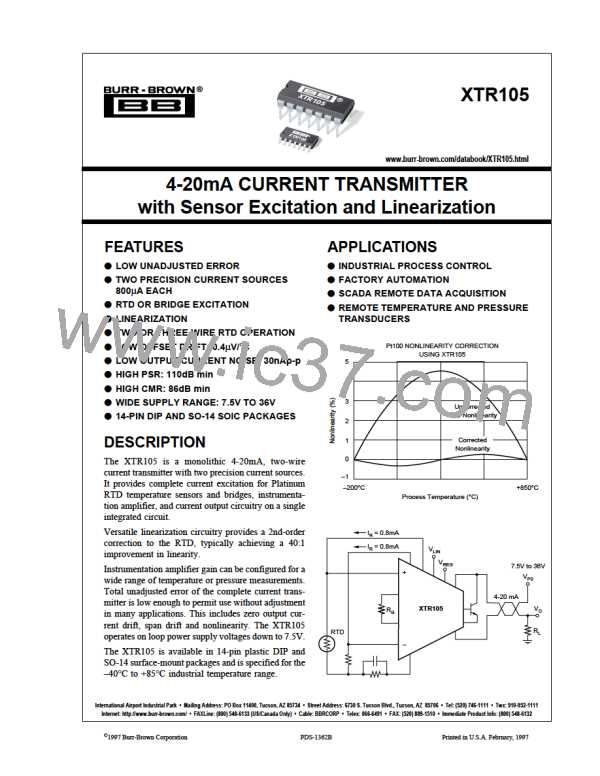A negative input voltage, VIN, will cause the output current
to be less than 4mA. Increasingly negative VIN will cause the
output current to limit at approximately 2.2mA. Refer to the
typical curve “Under-Scale Current vs Temperature.”
LOOP POWER SUPPLY
The voltage applied to the XTR105, V+, is measured with
respect to the IO connection, pin 7. V+ can range from 7.5V
to 36V. The loop supply voltage, VPS, will differ from the
voltage applied to the XTR105 according to the voltage drop
on the current sensing resistor, RL (plus any other voltage
drop in the line).
Increasingly positive input voltage (greater than the full-
scale input) will produce increasing output current according
to the transfer function, up to the output current limit of
approximately 27mA. Refer to the typical curve “Over-
Scale Current vs Temperature.”
If a low loop supply voltage is used, RL (including the loop
wiring resistance) must be made a relatively low value to
assure that V+ remains 7.5V or greater for the maximum
loop current of 20mA:
EXTERNAL TRANSISTOR
Transistor Q1 conducts the majority of the signal-dependent
4-20mA loop current. Using an external transistor isolates
the majority of the power dissipation from the precision
input and reference circuitry of the XTR105, maintaining
excellent accuracy.
(V+) – 7.5V
RL max =
– RWIRING
20mA
It is recommended to design for V+ equal or greater than
7.5V with loop currents up to 30mA to allow for out-of-
range input conditions.
Since the external transistor is inside a feedback loop its
characteristics are not critical. Requirements are: VCEO
=
45V min, β = 40 min and PD = 800mW. Power dissipation
requirements may be lower if the loop power supply voltage
is less than 36V. Some possible choices for Q1 are listed in
Figure 1.
The low operating voltage (7.5V) of the XTR105 allows
operation directly from personal computer power supplies
(12V ±5%). When used with the RCV420 Current Loop
Receiver (Figure 7), load resistor voltage drop is limited to 3V.
The XTR105 can be operated without this external transis-
tor, however, accuracy will be somewhat degraded due to
the internal power dissipation. Operation without Q1 is not
recommended for extended temperature ranges. A resistor
(R = 3.3kΩ) connected between the IRET pin and the E
(emitter) pin may be needed for operation below 0°C with-
out Q1 to guarantee the full 20mA full-scale output, espe-
cially with V+ near 7.5V.
ADJUSTING INITIAL ERRORS
Many applications require adjustment of initial errors. Input
offset and reference current mismatch errors can be cor-
rected by adjustment of the zero resistor, RZ. Adjusting the
gain-setting resistor, RG, corrects any errors associated with
gain.
TWO-WIRE AND
THREE-WIRE RTD CONNECTIONS
In Figure 1, the RTD can be located remotely simply by
extending the two connections to the RTD. With this remote
two-wire connection to the RTD, line resistance will intro-
duce error. This error can be partially corrected by adjusting
10
the values of RZ, RG, and RLIN1
.
V+
A better method for remotely located RTDs is the three-wire
RTD connection shown in Figure 3. This circuit offers
improved accuracy. RZ’s current is routed through a third
wire to the RTD. Assuming line resistance is equal in RTD
lines 1 and 2, this produces a small common-mode voltage
8
E
XTR105
0.01µF
IO
which is rejected by the XTR105. A second resistor, RLIN2
is required for linearization.
,
7
IRET
6
Note that although the two-wire and three-wire RTD con-
nection circuits are very similar, the gain-setting resistor,
RG, has slightly different equations:
For operation without external
transistor, connect a 3.3kΩ
resistor between pin 6 and
pin 8. See text for discussion
of performance.
RQ = 3.3kΩ
2R1(R2 + RZ ) – 4(R2RZ )
Two-wire:
RG =
R2 – R1
FIGURE 2. Operation Without External Transistor.
2(R2 – RZ )(R1 – RZ )
R2 – R1
Three-wire:
RG =
where RZ = RTD resistance at TMIN
R1 = RTD resistance at (TMIN + TMAX)/2
R2 = RTD resistance at TMAX
®
8

 BB [ BURR-BROWN CORPORATION ]
BB [ BURR-BROWN CORPORATION ]